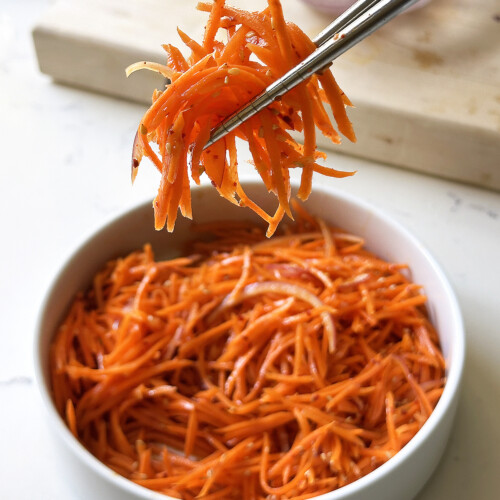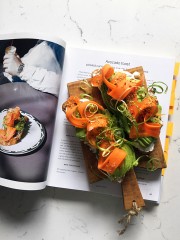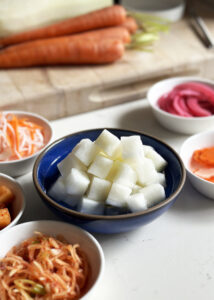Spicy Korean Radish Salad, or "Mu-saeng-chae" for the real ones, is a quick and easy dish you can throw together when you're craving something salty, crunchy and spicy. With only a few ingredients, it's super easy to make, and is a great stand-in for regular kimchi when you need that spicy funky fix. Shall we?

Jump to:
- So What is Spicy Korean Radish Salad aka "Musaengchae?"
- Mu-Saeng-chae vs Kkakdugi vs Chicken Mu vs Mu Namul...Korean Radish Banchans
- Is Spicy Korean Radish Salad Healthy?
- What Ingredients You Need for Spicy Korean Radish Salad
- What's the Best Radish for Spicy Korean Radish Salad/Musaengchae?
- How to Make Spicy Korean Radish Salad Musaengchae
- Pro Tips, Tricks, and Technique FAQs
- BEST and Easiest to Make Korean Vegetable Banchan
- Spicy Korean Radish Salad "Musaengchae" Recipe
So What is Spicy Korean Radish Salad aka "Musaengchae?"
Spicy Korean Radish Salad aka "musaengchae," spelled 무생채 in Korean, is a salty, spicy, and lightly tangy salad or slaw made from julienned Korean radish. Though it looks and sounds like it could be kimchi, musaengchae is not intended to ferment and store for a long period of time. Instead, musaengchae is meant to be made and eaten "fresh."
Musaengchae can be "white," seasoned with just salt, sugar and vinegar, to a deep dark reddish orange seasoned with a lot of gochugaru and even fish sauce to give it a deeper umami flavor.
No doubt you've seen versions of Spicy Korean Radish Salad as part of an array of banchan on a Korean dinner table. It can also be one of the five to seven vegetables on top of Bibimbap.

Mu-Saeng-chae vs Kkakdugi vs Chicken Mu vs Mu Namul...Korean Radish Banchans
All of these dishes are made from crisp, refreshing Korean radish and served as little side dishes known as banchan. However, kkakdugi, mu-saeng-chae, pickled radish, and mu namul are all distinct from one another in the way the radishes are cut, prepped, and seasoned.
Mu-saeng-chae 무생채 is a type of vinegar pickled radish made from julienned Korean radish that is seasoned with salt, sugar, and sometimes a little bit of red pepper. Since it's not fermented, you can also call it a salad. I LOVE this and used to buy giant pre-packed plastic containers of it from the Korean grocery store and just eat it straight from the container.
Kkakdugi 깍두기 is a type of radish kimchi, seasoned with spices and then fermented, which gives it its natural tartness. Korean radishes are almost always cut into small cubes. There are a few different types of kimchi made from different radishes; kkakdugi is this one shaped like cubes!
Chicken Mu 치킨무 is also a type of vinegar pickled radish made from Korean radish that is cut into small cubes, similar to kkakdugi, but not spicy, and not fermented. Chicken Mu is so named because it almost always accompanies Korean Fried Chicken.
Mu Namul 무나물 is the only one of these Korean radish dishes that isn't pickled or fermented. It is radish julienne that is sautéed with garlic and sesame. Mu namul is one of the vegetables on everyone's favorite Korean dish, Bibimbap.

Is Spicy Korean Radish Salad Healthy?
Depending on your health needs and dietary considerations, Spicy Korean Radish Salad can be healthy! To be honest, I can't really think of a case in which Musaengchae would not be healthy, unless maybe spice, acid from vinegar, or fiber causes heartburn or other gastric issue for you.
Though they are a root vegetables, Korean radishes are considered non-starchy vegetables so they are appropriate for low-sugar/low-carb lifestyles. And did you know that radishes are part of the Brassica family, the same family as broccoli, brussels sprouts, cauliflower and kale!
Radishes provide vitamin C, which along with a few other compunds, give radishes anti-cancer and anti-diabetes properties. Studies have shown that radishes also support healthy liver function and can improve cardiovascular health.
Health and Dietary Considerations of Spicy Korean Radish Salad
As published, this recipe for Spicy Korean Radish Salad is:
- 100% plant-based, suitable for vegans
- vegetarian
- dairy-free
- gluten-free
- wheat-free
- grain-free
- sugar-free
- keto, Whole30, low-carb
What Ingredients You Need for Spicy Korean Radish Salad
Spicy Korean Radish Salad/Musaengchae fresh/refrigerator ingredients:
- Korean radish, aka "mu"
- garlic
- green onions
Spicy Korean Radish Salad/Musaengchae dry/pantry ingredients:
- gochugaru
- rice vinegar
- sesame seeds
- salt
Sugar or other sweetener is optional if your Korean radish is particularly "hot," or you like foods with subtle sweetness.

What's the Best Radish for Spicy Korean Radish Salad/Musaengchae?
The recipe is called "Spicy Korean Radish Salad/Musaengchae" not only because it's a Korean dish, but because the radish itself is a Korean variety. Korean radish is called "mu" or "moo." It looks like a shorter, wider Japanese daikon radish with pale green skin at the neck and shoulders. It is slightly more dense than other radishes, and a more pronounced flavor, though radishes tend to have a mild flavor in general. Because the seasonings and spices in the final dish are very strong, Korean radish can stand up to them! I buy Korean radish at whatever Asian grocery store happens to be on my shopping route at the time.
The longer, narrower Japanese daikon radish is a near-exact substitute for Korean radish in almost any recipe, including this one. However, Japanese daikon tend to be a little less dense so they will release more liquid. Daikon radishes are generally more available in regular grocery stores where I live, Los Angeles. The biggest difference is that you may need a little more because they will shrink a little more than Korean radish when salted!
Additional Ingredients Notes and Resources
Gochugaru is a bright red Korean chili pepper powder made from a specific variety of Korean chili pepper. Its heat level ranges, but gochugaru is generally considered a medium spicy chili powder. Look for gochugaru that is made from Korean peppers that are sun-dried, and for this recipe specifically, a coarse grind, or flakes. You can find gochugaru in Korean grocery stores like H-Mart and other Asian grocery stores. I have also seen some independent, new-ish spice companies like this and this at Whole Foods. This organic brand and the one in the photo above, purchased at HMart, are currently what I have in my pantry.
Rice Vinegar. I use this brand organic brown rice vinegar. If you don't have rice vinegar, use any other light/mild vinegar like apple cider vinegar or white wine vinegar. Do not use distilled white vinegar, which you should only ever use to de-scale your coffee-maker.
Toasted Sesame Seeds add texture and when toasted, a layer of umami in addition to the toasted sesame oil. You can buy sesame seeds plain or toasted. Make sure the seeds are toasted. If they are not toasted, toss them in a hot, dry skillet over medium heat for about 90 seconds or until they are fragrant.
Garlic, ginger, green onions, and any other fresh herbs and produce from either the Santa Monica Farmers' Market on Wednesday, Mar Vista Farmers Market on Sunday, or Whole Foods Market when I can't find what I need at the farmers' market.
How to Make Spicy Korean Radish Salad Musaengchae

If you haven't already, peel Korean radish, carve out any little bruises or divots and slice into very thin matchsticks. I use a mandoline for this.

Place julienned radish in a large bowl, toss with 1 teaspoon salt, and let sit for at least 10 minutes, up to 30 minutes.

Drain radish and discard the liquid. Do not rinse the radish.

Add garlic, green onions, gochgaru, and sugar if you're using, to the radishes.

Mix the seasonings with the radish until all the radish matchsticks are evenly covered.

Transfer seasoned radishes to a large glass container with a tight-fitting lid like a glass jar or a serving dish if eating right away. And sprinkle with toasted sesame seeds and additional sliced green onions if you have them.
You can eat Korean Radish Salad right away; it will taste like spicy radish salad. If you make it in advance, after 1 day, it will be lightly fermented, more like a vinegar pickle.
Pro Tips, Tricks, and Technique FAQs
- Use your hands! You can use a large spoon to mix everything together, but nothing will get those seasoning ingredients absorbed into every last millimeter of surface area of those radishes like massaging it in with your hands. Highly recommend wearing disposable gloves though. Gochugaru is notorious for staining any and everything in its wake a deep reddish orange, including your hands, and especially light colored nail polish.
- Pint-size mason jar (16-ounces) fits this recipe. A pint-sized mason jar (16 ounces) is the exact size for this recipe. Get the wide mouth version because they are easier to fill AND to wash.
- Save your kimchi jars! If you buy kimchi in glass jars, wash and save the larger jars once you finish the kimchi and MAKE A VOW to yourself that you will indeed use them for making your own kimchi and Koran pickles and not just let the empty jar sit at the back of your storage drawer with all the other random odd sized jars and plastic tubs you've hoarded through the last 10 years. Yup, there, I said it.
- If this is your first time making Spicy Korean Radish Salad/Musaengchae, make this recipe exactly as is so you can get a feel for the technique and what you like in terms of flavor.
Tools and Equipment
As I say for just about any recipe, there isn't any special tool or piece of equipment required to make this Korean Radish Kimchi. You can make it using a sharp chef's knife on a sturdy cutting board to cut the radish! However, that isn't to say there are a few tools that might make it slightly easier to get the Korean Radish Kichi from the farmers market to your fork (or chopsticks), namely disposable gloves and large glass containers!
- Chef's knife, my personal workhorse
- Wooden cutting board, oversized for all those radish cubes
- Vegetable peeler once I switched to this from the old-school swivel style, I never looked back
- Disposable gloves I have stacks of boxes of nitrile exam gloves from Costco in my storage, but if you don't have a Costco membership, these are good substitute
- Glass mixing bowls
- Mini ¼-cup liquid measuring cup
- Glass storage containers with airtight lids
- Quart Glass mason Jars
- Glass 1-pint mason jars, wide mouth because they're easier to use and wash
- Mason jar lids that are better than those horrible 2-piece metal lids, these fit all jars labeled "wide-mouth"
How Long Can You Keep Spicy Korean Radish Salad/Musaengchae?
Though it looks like spicy kimchi and tastes pickled, Spicy Korean Radish Salad Musaengchae is considered a fresh preparation, not meant for long-term storage. Korean Radish Salad is best prepared and eaten the same day or within a few days. But to be honest, I highly doubt leftovers will be a problem.
How to Store Prepped or Leftover Spicy Korean Radish Salad/ Musaengchae
Refrigerator. You can keep Spicy Korean Radish Salad/Musaengchae in a tightly sealed container in the refrigerator for 1 week as long as you use clean utensils every time you remove some of the radish from the jar.
Freezer. Spicy Korean Radish Salad/Musaengchae does not freeze well. Just let it ferment in the refrigerator.

Ingredients Substitutions and FAQs
The recipe for this Spicy Korean Radish Salad/Musaengchae is considered "fool-proof" because it is very forgiving in terms of ingredient amounts, measurement precision, and technique, i.e. it is not "canning" and there is no watchfulness required. Here are the pro-tips:
- Different Radish? If you do not have access to Korean radish, you can substitute in Japanese daikon radish or even turnips! If you only have smaller round radishes, you can definitely use the same seasoning ingredients! The final dish will have a similar "spiycy Korean" vibe, but it will be you know, different.
- Different Hot Pepper Powder? Other hot pepper powders like cayenne and paprika are not recommended as they will render a totally different final dish. Use coarse ground gochugaru. The fine ground is too fine and is used to make gochujang.

How to Eat Spicy Korean Radish Salad/Musaengchae
Oh, you mean you can't just eat Spicy Korean Radish Salad/Musaengchae straight out of the jar with a pair of chopsticks standing over the kitchen sink and call that dinner?
Um, not that I've done that.
Not that I've not done that either.
Spicy Korean Radish Salad/Musaengchae is considered an accompanying side dish, "banchan." It is usually served with a few other little pickley, ferment-y vegetables on the table. When the main event is a hearty dish like Galbi Jjim, the spice and crispy crunchy texture of Spicy Korean Radish Salad/Musaengchae is the perfect counterbalance.
Pile Spicy Korean Radish Salad/Musaengchae over a bowl of fluffy steamed rice along with some of the bright orange liquid from the jar and now THAT you can call a dead-easy weeknight dinner. If you really want to get fancy, move it from the kitchen sink to the table and add any of the little dishes in the next section!

BEST and Easiest to Make Korean Vegetable Banchan
Why yes, I love spicy, pickley Korean banchans, how can you tell???
Here are some of the BEST, and easiest to make at home:
- Kkakdugi, Korean Radish Kimchi - my version is ginger-forward, and cut into smaller dice to make it impossibly poppable
- Oi Muchim, Korean Spicy Cucumbers - your summer weeknight kitchen counter dinners will never look back
- Spicy Korean Carrot Salad - tiktok famous, even better here
- Korean Sesame Spinach - no one will ever say you aren't getting enough greens because you'll be eating this spinach by the mixingbowlful on the regular
Spicy Korean Radish Salad "Musaengchae" Recipe
Ingredients
- 1 pound Korean radish “mu” about 1 medium radish
- 1 teaspoon sea salt
- 1-2 cloves garlic, finely minced
- 2 scallions, cut into ¾-inch pieces
- 2 tablespoons gochugaru coarse grind
- 2 tablespoons rice vinegar
- optional: up to 1 tablespoon sugar
Instructions
- Peel and julienne radish into thin matchsticks. Place radish in a large bowl, toss with salt . Leave salted radish in bowl to draw out liquid for 10 minutes, up to 30 minutes.
- Drain liquid from radish, gently pressing on radish or squeezing with hands. Discard salty liquid.
- Add garlic, green onions, gochgaru, and vinegar to the radishes. Mix the seasonings with the radish until everything is evenly distributed.
- If you are eating Spicy Korean Radish Salad immediatemyl, transfer to a serving bowl, garnish with toasted sesame seeds.
- If you are going to store the Spicy Korean Radish Salad to eat within the next couple of days, transfer seasoned radishes to a large glass container with a tight-fitting lid like a glass jar. Garnich with toasted sesame seeds just before serving.












Craig says
Since I can't fall asleep due to a beeping smoke alarm, i will say that pickled onions are great, ever have the pickled scallions (the little white onions) from the Japanese market, they are addictive.
deana (lostpastremembered) says
Those are the sexiest onions I've ever seen, great photo! I can't wait to try the onions!
Diana says
Even though I see that these are red onions from the name of the recipe, the title of the blog post, and your discussion of them, when I look at the picture, I think, red peppers.
Either way, they look very edible.
Sarah J. Gim says
Diana: I know! So red! I used an iPhone, no Photoshop (just emailed straight to flickr), and the photo is true to the color. Usually pickled red onions come out pink, but these were so red! I was surprised. I think it might have been the abundance of spices in the pickling liquid.
MrsDocChuck says
I was forbidden from calling the onions "ban chan" and from eating them with my secret chopsticks.
Lawan says
What do you do with the toasted seeds?
Adina says
How long do these last?
TheDelicious says
up to a week! (though quite honestly, they don't actually "last" that long in our house :) )